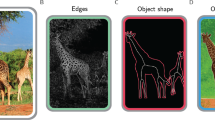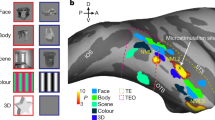Abstract
Previous investigations of the neural code for complex object shape have focused on two-dimensional pattern representation. This may be the primary mode for object vision given its simplicity and direct relation to the retinal image. In contrast, three-dimensional shape representation requires higher-dimensional coding derived from extensive computation. We found evidence for an explicit neural code for complex three-dimensional object shape. We used an evolutionary stimulus strategy and linear/nonlinear response models to characterize three-dimensional shape responses in macaque monkey inferotemporal cortex (IT). We found widespread tuning for three-dimensional spatial configurations of surface fragments characterized by their three-dimensional orientations and joint principal curvatures. Configural representation of three-dimensional shape could provide specific knowledge of object structure to support guidance of complex physical interactions and evaluation of object functionality and utility.
This is a preview of subscription content, access via your institution
Access options
Subscribe to this journal
Receive 12 print issues and online access
$209.00 per year
only $17.42 per issue
Buy this article
- Purchase on Springer Link
- Instant access to full article PDF
Prices may be subject to local taxes which are calculated during checkout






Similar content being viewed by others
Change history
12 October 2008
In the version of this article initially published online, Figure 1 was too small to evaluate the data being presented. The figure has been enlarged for the print, PDF and HTML versions of this article.
References
Ungerleider, L.G. & Mishkin, M. Analysis of Visual Behavior (eds. Ingle, D.G., Goodale, M.A. & Mansfield, R.J.Q.) 549–586 (MIT Press, Cambridge, Massachusetts, 1982).
Felleman, D.J. & Van Essen, D.C. Distributed hierarchical processing in the primate cerebral cortex. Cereb. Cortex 1, 1–47 (1991).
Anzai, A., Peng, X. & Van Essen, D.C. Neurons in monkey visual area V2 encode combinations of orientations. Nat. Neurosci. 10, 1313–1321 (2007).
Ito, M. & Komatsu, H. Representation of angles embedded within contour stimuli in area V2 of macaque monkeys. J. Neurosci. 24, 3313–3324 (2004).
Gallant, J.L., Braun, J. & Van Essen, D.C. Selectivity for polar, hyperbolic and Cartesian gratings in macaque visual cortex. Science 259, 100–103 (1993).
Pasupathy, A. & Connor, C.E. Shape representation in area V4: position-specific tuning for boundary conformation. J. Neurophysiol. 86, 2505–2519 (2001).
Pasupathy, A. & Connor, C.E. Responses to contour features in macaque area V4. J. Neurophysiol. 82, 2490–2502 (1999).
Pasupathy, A. & Connor, C.E. Population coding of shape in area V4. Nat. Neurosci. 5, 1332–1338 (2002).
Brincat, S.L. & Connor, C.E. Underlying principles of visual shape selectivity in posterior inferotemporal cortex. Nat. Neurosci. 7, 880–886 (2004).
Brincat, S.L. & Connor, C.E. Dynamic shape synthesis in posterior inferotemporal cortex. Neuron 49, 17–24 (2006).
Malach, R. et al. Object-related activity revealed by functional magnetic resonance imaging in human occipital cortex. Proc. Natl. Acad. Sci. USA 92, 8135–8139 (1995).
Kourtzi, Z. & Kanwisher, N. Representation of perceived object shape by the human lateral occipital complex. Science 293, 1506–1509 (2001).
Tsao, D.Y., Freiwald, W.A., Knutsen, T.A., Mandeville, J.B. & Tootell, R.B.H. Faces and objects in macaque cerebral cortex. Nat. Neurosci. 6, 989–995 (2003).
Gross, C.G., Rocha-Miranda, C.E. & Bender, D.B. Visual properties of neurons in inferotemporal cortex of the Macaque. J. Neurophysiol. 35, 96–111 (1972).
Schwartz, E.L., Desimone, R., Albright, T.D. & Gross, C.G. Shape recognition and inferior temporal neurons. Proc. Natl. Acad. Sci. USA 80, 5776–5778 (1983).
Kobatake, E. & Tanaka, K. Neuronal selectivities to complex object features in the ventral visual pathway of the macaque cerebral cortex. J. Neurophysiol. 71, 856–867 (1994).
Fujita, I., Tanaka, K., Ito, M. & Cheng, K. Columns for visual features of objects in monkey inferotemporal cortex. Nature 360, 343–346 (1992).
Tsunoda, K., Yamane, Y., Nishizaki, M. & Tanifuji, M. Complex objects are represented in macaque inferotemporal cortex by the combination of feature columns. Nat. Neurosci. 4, 832–838 (2001).
Baker, C.I., Behrmann, M. & Olson, C.R. Impact of learning on representation of parts and wholes in monkey inferotemporal cortex. Nat. Neurosci. 5, 1210–1216 (2002).
Quiroga, R.Q., Reddy, L., Kreiman, G., Koch, C. & Fried, I. Invariant visual representation by single neurons in the human brain. Nature 435, 1102–1107 (2005).
Freedman, D.J., Riesenhuber, M., Poggio, T. & Miller, E.K. Categorical representation of visual stimuli in the primate prefrontal cortex. Science 291, 312–316 (2001).
Marr, D. & Nishihara, H.K. Representation and recognition of the spatial organization of three-dimensional shapes. Proc. R. Soc. Lond. B 200, 269–294 (1978).
Biederman, I. Recognition-by-components: a theory of human image understanding. Psychol. Rev. 94, 115–147 (1987).
Vetter, T., Hurlbert, A. & Poggio, T. View-based models of 3D object recognition: invariance to imaging transformations. Cereb. Cortex 5, 261–269 (1995).
Bulthoff, H.H., Edelman, S.Y. & Tarr, M.J. How are three-dimensional objects represented in the brain? Cereb. Cortex 5, 247–260 (1995).
Tarr, M.J. & Pinker, S. Mental rotation and orientation-dependence in shape recognition. Cognit. Psychol. 21, 233–282 (1989).
Riesenhuber, M. & Poggio, T. Hierarchical models of object recognition in cortex. Nat. Neurosci. 2, 1019–1025 (1999).
Serre, T., Oliva, A. & Poggio, T. A feedforward architecture accounts for rapid categorization. Proc. Natl. Acad. Sci. USA 104, 6424–6429 (2007).
Tarr, M.J. & Barenholtz, E. Reconsidering the role of structure in vision. in The Psychology of Learning and Motivation (eds. Ross, B. & Markman, A.) 157–180 (Academic Press, London, 2007).
Janssen, P., Vogels, R. & Orban, G.A. Macaque inferior temporal neurons are selective for disparity-defined three-dimensional shapes. Proc. Natl. Acad. Sci. USA 96, 8217–8222 (1999).
Uka, T., Tanaka, H., Yoshiyama, K., Kato, M. & Fujita, I. Disparity selectivity of neurons in monkey inferior temporal cortex. J. Neurophysiol. 84, 120–132 (2000).
Watanabe, M., Tanaka, H., Uka, T. & Fujita, I. Disparity-selective neurons in area V4 of macaque monkeys. J. Neurophysiol. 87, 1960–1973 (2002).
Hinkle, D.A. & Connor, C.E. Three-dimensional orientation tuning in macaque area V4. Nat. Neurosci. 5, 665–670 (2002).
Janssen, P., Vogels, R. & Orban, G.A. Three-dimensional shape coding in inferior temporal cortex. Neuron 27, 385–397 (2000).
Sakata, H. et al. Neural coding of 3D features of objects for hand action in the parietal cortex of the monkey. Phil. Trans. R. Soc. Lond. B 353, 1363–1373 (1998).
Rust, N.C., Mante, V., Simoncelli, E.P. & Movshon, A. How MT cells analyze the motion of visual patterns. Nat. Neurosci. 9, 1421–1431 (2006).
Ito, M., Tamura, H., Fujita, I. & Tanaka, K. Size and position invariance of neuronal responses in monkey inferotemporal cortex. J. Neurophysiol. 73, 218–226 (1995).
Connor, C.E., Brincat, S.L. & Pasupathy, A. Transformation of shape information in the ventral pathway. Curr. Opin. Neurobiol. 17, 140–147 (2007).
Hoffman, D.D. & Richards, W.A. Parts of recognition. Cognition 18, 65–96 (1984).
Koenderink, J.J. What does the occluding contour tell us about solid shape? Perception 13, 321–330 (1984).
Edelman, S. & Poggio, T. Models of object recognition. Curr. Opin. Neurobiol. 1, 270–273 (1991).
Wang, G., Obama, S., Yamashita, W., Sugihara, T. & Tanaka, K. Prior experience of rotation is not required for recognizing objects seen from different angles. Nat. Neurosci. 8, 1768–1775 (2005).
Roelfsema, P.R. Cortical algorithms for perceptual grouping. Annu. Rev. Neurosci. 29, 203–227 (2006).
Rolls, E.T. & Treves, A. The relative advantages of sparse versus distributed encoding for associative neuronal networks in the brain. Network 1, 407–421 (1990).
Vinje, W.E. & Gallant, J.L. Sparse coding and decorrelation in primary visual cortex during natural vision. Science 287, 1273–1276 (2000).
Janssen, P., Vogels, R. & Orban, G.A. Selectivity for 3D shape that reveals distinct areas within macaque inferotemporal cortex. Science 288, 2054–2056 (2000).
Acknowledgements
We thank B. Nash, B. Quinlan, C. Moses and L. Guruvadoo for technical support, and J. Bastian, A. Bastian, T. Poggio and M. Riesenhuber for comments on the manuscript. This work was supported by a grant from the US National Institutes of Health to C.E.C.
Author information
Authors and Affiliations
Corresponding author
Supplementary information
Supplementary Text and Figures
Supplementary Figures 1–17 (PDF 2453 kb)
Rights and permissions
About this article
Cite this article
Yamane, Y., Carlson, E., Bowman, K. et al. A neural code for three-dimensional object shape in macaque inferotemporal cortex. Nat Neurosci 11, 1352–1360 (2008). https://doi.org/10.1038/nn.2202
Received:
Accepted:
Published:
Issue Date:
DOI: https://doi.org/10.1038/nn.2202
This article is cited by
-
Development of visual object recognition
Nature Reviews Psychology (2023)
-
Electrophysiological dataset from macaque visual cortical area MST in response to a novel motion stimulus
Scientific Data (2022)
-
Processing of visual statistics of naturalistic videos in macaque visual areas V1 and V4
Brain Structure and Function (2022)
-
Brain-inspired models for visual object recognition: an overview
Artificial Intelligence Review (2022)
-
Interaction of surface pattern and contour shape in the tilt after effects evoked by symmetry
Scientific Reports (2021)



